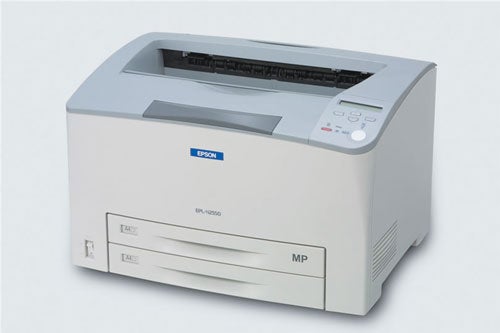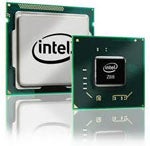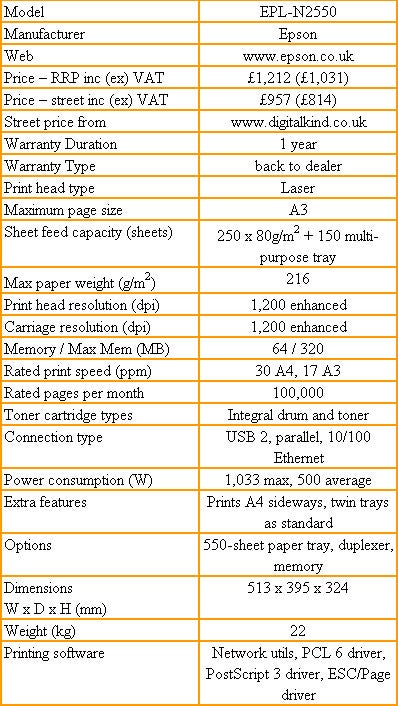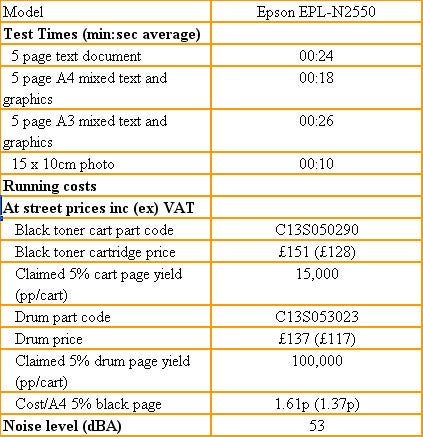Epson EPL-N2550 A3 Mono Laser Printer Review
Epson EPL-N2550 A3 Mono Laser Printer
A3 mono lasers are rare beasts and this one from Epson seems expensive. Is it worth the money?

Verdict
Key Specifications
- Review Price: £957.00
It’s not often we test an A3 mono laser printer as few companies need the larger size in a black and white print. That might be part of the reason you’ll get little change out of £1,000 for this Epson workgroup machine. Another reason could well be the fast claimed print speeds of 30ppm for A4 and 17ppm for A3 pages. Even so, at first glance, it looks expensive.
Epson claims the EPL-N2550 has a comparable footprint to an A4 laser, but that’s only true if you’re thinking of a pretty substantial colour A4 laser. This is a big machine, though Epson has tried to mitigate this with an innovative expandable paper tray design.
Pull out either of the paper trays and you can ‘unlock’ them so they telescope out to twice their original size. They then project out from the front of the printer, of course, but you can have one, both or neither expanded, depending on what you’re printing. The design of the trays does make them more awkward to slide back into the printer.
Cleverly, if you have one tray set for A3 and the other for A4 paper, the printer will automatically select the right tray when you pick the size of paper to print on from the driver – you don’t have to explicitly select a paper tray.
The 16-character LCD display has no backlight, but unusually is easily readable under normal overhead lighting. For buttons below the display control the menus and there’s a red, job-cancel button, too. At the back are three sockets for USB 2.0, parallel and 10/100 Ethernet. The EPL-N2550 is fully network-ready as standard.
A single drum and toner cartridge slots in through a hatch in the printer’s top surface and may well represent the only kind of maintenance you ever have to apply. Although this cartridge is rated at 15,000, A4 pages, the photoconductor drum is rated at 100,000 pages. Even under fairly heavy use, you may never need a second drum during the lifetime of the printer.
Software installation is straightforward, as long as you remember to install the driver before connecting any cables to the printer. The driver includes all the expected options, though some other defaults such as the options preset for printing photographic images don’t do the machine justice.
An interesting feature is a facility to magnify a page image onto a different size of paper. By specifying a zoom level of 141 per cent for example, you can enlarge an A4 print exactly onto A3 paper.
The quoted A4 print speed of 30ppm isn’t realistic when printing in normal mode – as we do – though you might get somewhere near it in draft. The best we could achieve was 17ppm, and this with our five page text and graphics print. Even though it include graphics, it was quicker to print than straight text, because it prints the same page five times, rather than having to rasterise five different pages. Epson claims up to 17ppm for A3 prints and we managed 12ppm, which isn’t that far off. Our 15 x 10cm photo print took just 10 seconds, or 6ppm.
Print quality was generally very good, with text almost like dry print and business graphics were clean with well-defined tints and no banding. Once we had the right settings for photos, the test photo also came out well, with smooth gradations of tint and sharply defined detail. The printer has a physical resolution of 600dpi, boosted to 1,200 by Epson’s software RI Technology
Even if you include the drum cost in your running cost calculations, as we did because a workgroup printer might print more than 100,000 pages, the running costs come out low. We calculate 1.61p per A4 page, not the lowest cost we’ve seen for a mono page, but down among the best.
Since the EPL-N2550 is sold as an A3 printer, you need to bear in mind that these costs are based on A4 pages. This is reasonable for comparison purposes, since running costs for most mono and colour lasers will be quoted in the same terms. If the majority of your work will be printing A3 pages, however, you can expect anything down to half the page yield and hence double the cost.
”’Verdict”’
At second glance, the EPL-N2550 still looks expensive, though it does most of what it claims on the box. Print speeds are fanciful, but then they always are and at least this printer feeds sheets out at a good pace. It’s expandable trays make it very flexible in what it prints and print quality is certainly up to the mark. We guess it’s priced at what the market will bear but we don’t think it’s really worth £400 more than an equivalent A4 machine, such as the the EPL-N3000.


Trusted Score
Score in detail
-
Print Speed 9
-
Features 7
-
Value 6
-
Print Quality 8
Features
| Networking | Fast Ethernet |
Printing
| Duplex | Manual |
| Paper Size | A5, A4, A3, B5, B4, Letter, Half-letter, Executive, Legal, Govt. Legal, Ledger B Size, Govt. Letter, F4, Monarch Envelope, Com10 Envelope, DL Envelope, C5 Envelope, C6 Envelope, Custom Size |
| Sheet Capacity | 400 sheets |
| Rated Black Speed (Images per minute) | 30 ppmipm |

